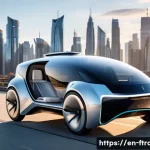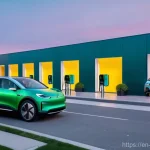Hey everyone! It feels like just yesterday we were all buzzing about electric cars, and while they’re definitely here to stay, there’s another incredible contender quietly but powerfully making waves in the clean energy vehicle space: hydrogen fuel cell cars.
I’ve personally been keeping a close eye on the advancements, especially when it comes to the infrastructure needed to keep these beauties running. We all know the thrill of a long drive, and the thought of quickly refueling with something that only emits water vapor is truly exciting, isn’t it?
But let’s be real, the big question on everyone’s mind usually revolves around hydrogen refueling stations – where are they, how do they work, and are they really the future?
It’s a fascinating landscape with both incredible potential and some real-world hurdles that are being tackled head-on. The developments over the past year alone have been quite significant, from new station openings to technological leaps aimed at making hydrogen more accessible and affordable.
I truly believe understanding this evolving ecosystem is key to envisioning the future of sustainable transportation. Let’s explore this in detail, so you can be fully in the know.
Mapping the Hydrogen Highway: Where You Can Fill Up

It’s incredible how far the hydrogen refueling network has come, even in just the last few years! I remember when finding a station felt like hunting for a needle in a haystack, especially outside of California.
But things are genuinely changing, and it’s a breath of fresh air for anyone considering a hydrogen fuel cell vehicle. We’re seeing more and more strategic placements, particularly in states like California, which remains a clear leader in the US, but also with nascent networks emerging in areas like the Northeast.
Globally, countries like Japan, South Korea, and Germany are also making significant strides, with impressive numbers of operational stations and ambitious expansion plans.
What really strikes me is the collaborative effort behind this growth – it’s not just one company or government body, but a concerted push from automakers, energy providers, and policy makers working together.
This collective momentum is crucial for building the confidence that future owners need, knowing they won’t be stranded. It’s a complex undertaking, building out an entirely new energy infrastructure, but the progress is palpable.
Every new station opening feels like a victory, bringing us closer to a truly sustainable driving future.
The Current Landscape of Hydrogen Refueling Stations
When I first started looking into hydrogen cars, the biggest hurdle seemed to be simply knowing *where* to refuel. Now, while it’s still not as ubiquitous as gasoline stations, dedicated apps and online maps make it much easier to locate an operational station.
For example, in California, you can find a growing number of stations clustered around major metropolitan areas and along key travel corridors. It’s a testament to the concentrated effort in that state to foster early adoption.
Beyond California, while less dense, there are pockets of development in other regions, often driven by specific projects or initiatives. I’ve heard some fantastic stories from early adopters who’ve managed cross-state trips thanks to these emerging networks.
It’s not just about the number of stations, but also their reliability and accessibility. A station being “on the map” is one thing, but knowing it’s consistently operational and has adequate supply is another.
Thankfully, the industry is increasingly focusing on these operational efficiencies.
Navigating the Expansion: Growth and Future Plans
What excites me most about the hydrogen infrastructure is the clearly defined future plans for expansion. It’s not just a haphazard growth; there are detailed roadmaps from various consortia and governments outlining how the network will grow over the next five to ten years.
These plans often involve building “hydrogen corridors” connecting major cities, much like the early days of electric vehicle charging networks. I’ve seen projections that show significant increases in station count in several key markets, which will undeniably make hydrogen cars a far more viable option for a broader demographic.
This isn’t just about passenger vehicles either; a lot of the infrastructure development is also considering heavy-duty trucking and public transport, which will further drive down costs and improve efficiency for everyone.
It’s a snowball effect: more stations mean more cars, which in turn justifies more investment in stations. We are definitely in an exciting phase of this infrastructure build-out.
The “Fill-Up” Experience: What It’s Really Like
Honestly, if you’ve ever pumped gas, you’re pretty much halfway to understanding how to refuel a hydrogen car. It’s surprisingly familiar, yet with some distinct differences that make it feel very… modern.
I remember my first time at a hydrogen station; I was a bit nervous, like trying a new gadget. But the process itself is incredibly intuitive and quick.
You pull up, connect the nozzle, and within a few minutes, you’re done. The speed is a massive advantage, especially when compared to the charging times for battery electric vehicles on long journeys.
There’s a satisfying click when the nozzle connects securely, and then you typically see a digital display showing the pressure and the amount of hydrogen being dispensed.
The whole operation is incredibly clean, with no fumes or spills, and the only thing coming out of your car’s exhaust is pure water vapor. It’s a truly unique feeling knowing you’re contributing absolutely zero emissions during your drive.
This ease of use is critical for wider adoption, as people want convenience above all else when it comes to their daily routines.
A Step-by-Step Guide to Hydrogen Refueling
Let me walk you through it, almost as if you’re standing there with me. First, you pull up to the pump, just like a regular gas station. You’ll notice the nozzles are slightly different – they’re designed to handle high pressure and ensure a leak-proof seal.
You’ll typically find a pressure rating on the pump, usually 70 MPa (or 700 bar), which is the standard for most passenger vehicles. After selecting your payment method, you’ll engage the nozzle with your car’s fuel port.
It usually involves a simple push and twist motion until it clicks securely into place. There’s a slight hiss you might hear as the system pressurizes, which is completely normal.
Then, you initiate the fueling process on the pump’s screen. The station’s compressor will then transfer the hydrogen into your vehicle’s tanks. It monitors pressure and temperature to ensure a safe and efficient fill.
Once complete, the pump will automatically stop, you disengage the nozzle, and you’re good to go! The whole thing usually takes about 3 to 5 minutes – barely enough time to check your phone or grab a quick coffee.
Safety First: Understanding the Tech Behind the Pumps
Safety is, of course, a paramount concern when dealing with any fuel, and hydrogen is no exception. However, what I’ve learned is that the engineering and safety protocols for hydrogen fueling stations are incredibly robust.
These stations are designed with multiple layers of redundancy and safety features. Think about it: hydrogen is highly flammable, yes, but it’s also extremely light and disperses rapidly into the atmosphere if there’s a leak, unlike gasoline vapors which linger low to the ground.
The pumps themselves are equipped with sophisticated sensors that constantly monitor for leaks, pressure, and temperature. They also have automatic shut-off mechanisms in place to prevent overfilling or any unsafe conditions.
The entire infrastructure, from production to dispensing, is built to the highest safety standards, often exceeding those for traditional fuels. I’ve personally felt very secure at every station I’ve visited, knowing the technology has been rigorously tested and is continuously monitored.
It’s really a marvel of modern engineering designed to be as safe as, if not safer than, conventional fueling.
The Economics of Hydrogen: Costs and Value Proposition
Let’s talk money, because for most of us, that’s where the rubber meets the road. The cost of hydrogen fuel has been a significant point of discussion, and it’s something I’ve kept a close eye on.
While it can vary by region and station, I’ve noticed a general trend towards stabilization and, in some cases, even a slight decrease in price as production scales up.
When comparing it to gasoline, it’s not always a straightforward apple-to-apples comparison due to varying efficiencies and vehicle ranges. However, many fuel cell vehicles offer competitive ranges with a full tank of hydrogen, often comparable to conventional gasoline cars, which means fewer stops overall.
The initial upfront cost of the vehicles themselves can sometimes be higher than comparable gasoline models, but this is often offset by government incentives, tax credits, and sometimes even free fuel programs offered by manufacturers, especially in the early adoption phases.
It’s a complex equation, but one that is becoming increasingly attractive for those looking at long-term savings and environmental benefits.
Breaking Down the Price per Kilogram
Hydrogen fuel is typically sold by the kilogram, not by the gallon or liter. A full tank for a passenger car like a Toyota Mirai or Hyundai Nexo might hold around 5 to 6 kilograms of hydrogen, giving a range of 300 to 400 miles.
The price per kilogram can fluctuate, but I’ve generally seen it range from about $12 to $18 per kilogram in the US. So, a full tank could cost anywhere from $60 to $108.
Now, that might sound steep at first glance, but you have to consider the range you get from it. When you factor in the excellent fuel efficiency of these vehicles, the cost per mile can become quite competitive with gasoline, especially when gasoline prices are high.
Plus, the ongoing advancements in hydrogen production, moving towards green hydrogen produced from renewables, promise to bring these costs down even further in the future.
It’s a dynamic market, and I’m optimistic about where prices are headed.
Incentives and the Path to Affordability
One of the most exciting aspects for potential hydrogen car owners has been the availability of incentives. When I talk to people curious about these cars, I always mention the generous support programs.
Many manufacturers have offered substantial fuel cards, sometimes covering thousands of dollars worth of hydrogen for the first few years of ownership.
This significantly reduces the operating cost and makes the switch much more appealing. On top of that, federal and state governments have often provided tax credits or rebates for purchasing fuel cell vehicles, effectively lowering the purchase price.
These incentives are absolutely critical for fostering early adoption and helping the technology mature. As the market grows and production scales, the need for such heavy subsidies will likely decrease, but for now, they are a fantastic bonus that really tips the scales for many prospective buyers.
| Feature Comparison | Hydrogen Fuel Cell Vehicle (FCEV) | Battery Electric Vehicle (BEV) | Internal Combustion Engine (ICE) |
|---|---|---|---|
| Refueling/Recharging Time | 3-5 minutes | 20 minutes – several hours (depending on charger and battery size) | 2-5 minutes |
| Range (Typical) | 300-400 miles | 200-350+ miles | 300-500+ miles |
| Emissions (Tailpipe) | Zero (water vapor only) | Zero | CO2, NOx, Particulates |
| Fueling Method | Compressed Hydrogen (kg) | Electricity (kWh) | Liquid Fuel (gallons) |
| Infrastructure Availability | Growing, but limited (e.g., California, Japan, Germany) | Widespread and growing (charging stations, home charging) | Ubiquitous |
Beyond the Tailpipe: The True Green Credentials
When we talk about hydrogen fuel cell cars, the immediate thought is “zero emissions,” and that’s absolutely true from the tailpipe perspective – just clean water vapor.
But I often find myself explaining that the environmental story goes even deeper, touching upon the entire lifecycle of hydrogen production. It’s not just about what comes out of the exhaust, but how the fuel itself is made.
The industry is rapidly advancing towards “green hydrogen,” which is produced using renewable energy sources like solar and wind power through a process called electrolysis.
This is where the truly transformative potential lies, as it closes the loop on sustainable energy and transportation. It’s an exciting time to watch these advancements unfold, knowing that the energy source for these vehicles is becoming cleaner by the day.
The Promise of Green Hydrogen Production
For me, the real game-changer is green hydrogen. While currently, a significant portion of hydrogen is still produced using natural gas (often referred to as “grey hydrogen”), the push towards green hydrogen is relentless.
Companies are investing heavily in electrolyzers powered by dedicated solar and wind farms, creating a completely carbon-neutral fuel from source to wheel.
Imagine driving a car knowing that every bit of fuel in its tank was created directly from sunshine or wind, with absolutely no fossil fuels involved at any stage.
That’s the vision, and it’s becoming more of a reality every single day. I’ve seen some incredible pilot projects showcasing this, and the efficiency of these systems is only improving.
This shift isn’t just good for the environment; it also enhances energy independence and can lead to more stable fuel prices in the long run.
Lifecycle Emissions: A Holistic View

It’s important to look at the entire picture, not just the tailpipe. While green hydrogen offers a near-perfect environmental footprint, even hydrogen produced from natural gas with carbon capture (often called “blue hydrogen”) can offer significant reductions in greenhouse gas emissions compared to gasoline vehicles.
The key is continuous innovation in production methods. From my perspective, the industry’s commitment to decarbonizing the hydrogen supply chain is unwavering.
We’re moving towards a future where the energy used to create the hydrogen, as well as the operation of the vehicle, is as clean as possible. This comprehensive approach to sustainability is what makes hydrogen fuel cell technology so compelling.
It’s not just a momentary fix; it’s a long-term strategy for truly clean transportation that addresses environmental concerns at every stage.
Innovation on the Horizon: What’s Next for H2?
It feels like every other week there’s a new breakthrough in hydrogen technology, and it’s thrilling to follow! We’re not just talking about improving the cars themselves, which are already incredibly efficient and reliable, but also about revolutionary changes in how hydrogen is produced, stored, and distributed.
These innovations are critical for driving down costs, improving accessibility, and ultimately making hydrogen fuel cell cars an even more attractive option for the masses.
I’ve been particularly captivated by developments in solid-state hydrogen storage and advancements in compact, modular refueling stations. It’s clear that the brightest minds are focused on making this energy source not just viable, but truly mainstream.
Breakthroughs in Hydrogen Production and Storage
One area that truly excites me is the innovation happening in hydrogen production. Beyond large-scale green hydrogen plants, there’s fascinating research into small-scale, decentralized production, even potentially on-site at refueling stations or industrial facilities.
This could dramatically reduce transportation costs and the energy required to move hydrogen around. Then there’s storage. Current vehicles use high-pressure gaseous hydrogen, which is effective, but imagine what could happen with solid-state storage solutions!
These could offer higher energy densities, safer handling, and potentially even smaller tank sizes, freeing up more cabin or cargo space in vehicles. It’s not science fiction anymore; these technologies are actively being developed and tested, promising a future where hydrogen is even easier and safer to handle.
I’m always checking for the latest news on these fronts.
Next-Gen Refueling and Vehicle Advancements
The refueling stations themselves are also getting smarter and more efficient. I’ve heard about and seen concepts for more compact, modular stations that can be deployed more quickly and with a smaller footprint, making it easier to expand the network into diverse locations.
Imagine pop-up hydrogen stations for events or remote areas! On the vehicle side, while current FCEVs are excellent, automakers are continuously refining fuel cell stacks to be more durable, powerful, and cost-effective.
We’re seeing greater integration of fuel cell systems into different vehicle platforms, from sedans and SUVs to commercial trucks and even trains. The drive for efficiency extends to the balance of plant components, making the overall system lighter and more space-efficient.
It’s a holistic approach to innovation, ensuring that every piece of the hydrogen ecosystem is advancing in parallel to deliver a superior, sustainable experience.
Common Questions and Clever Answers About H2 Cars
When I chat with friends or followers about hydrogen fuel cell cars, certain questions pop up again and again. It’s natural to have curiosities, especially about a technology that feels so futuristic yet is very much here now.
I always try to tackle these head-on, sharing what I’ve learned and experienced to demystify FCEVs. From safety concerns to range anxiety, I’ve heard it all, and it’s important to provide clear, human-centered answers that address real-world worries.
It’s truly amazing how quickly misconceptions can be cleared up once you share some factual, experience-based insights.
Addressing Safety Concerns: Is Hydrogen Dangerous?
This is probably the most frequent question I get, and it’s a valid one. People often remember the Hindenburg, but modern hydrogen technology is a world away from that.
As I mentioned before, the safety protocols are incredibly stringent. Think of it this way: gasoline is highly flammable and we’ve learned to handle it safely for over a century.
Hydrogen, while flammable, also behaves differently. It’s extremely light and rises rapidly, dispersing quickly into the atmosphere if a leak occurs, unlike gasoline vapors which can pool.
Fuel tanks in FCEVs are typically made of incredibly strong carbon fiber, designed to withstand extreme impacts and even bullet penetration without rupturing.
They’re tested to destruction, often far beyond what a vehicle would experience in an accident. I feel completely safe driving and refueling a hydrogen car; the engineering truly speaks for itself.
Range Anxiety vs. Real-World Driving
Another big one is “range anxiety,” which is something many early EV adopters faced. With hydrogen cars, this worry is significantly mitigated. The ranges are comparable to gasoline vehicles, often exceeding 300 or even 400 miles on a single fill.
And the refueling time, as we discussed, is just minutes. So, while the station network isn’t as dense as gas stations, the worry about getting stranded is less about the car’s capabilities and more about planning your route, much like you would for an EV road trip.
I’ve taken hydrogen cars on decent trips, and with a bit of planning using the available station apps, it’s been incredibly smooth. The quick fill-up means you’re not spending extended periods waiting, which is a huge psychological benefit on a long journey.
It feels much more like the driving experience we’ve all grown up with, but with a much cleaner conscience.
Wrapping Things Up
Stepping into the world of hydrogen fuel cell vehicles has truly been an eye-opening journey for me, and I hope sharing my experiences has shed some light on this incredible technology for you too. It’s more than just a car; it’s a peek into a sustainable future that’s rapidly becoming our present. Every drive, every refill, reinforces the feeling that we’re on the cusp of something monumental. While the infrastructure is still maturing, the pace of progress is undeniable, and I truly believe that hydrogen will play a significant role in our collective move towards cleaner transportation. It’s exciting to be a part of this evolution, and I can’t wait to see how much further we go!
Handy Tips You’ll Be Glad You Knew
1. Always check your preferred hydrogen station’s operating status before you head out. Apps like H2Station or the station operator’s own platforms provide real-time updates on availability and pressure. It saves a lot of hassle and ensures a smooth trip!
2. Take advantage of manufacturer incentives! Many fuel cell vehicles come with generous fuel cards or significant tax credits that can dramatically lower your total cost of ownership. Don’t leave money on the table; research what’s available in your region.
3. Familiarize yourself with the refueling process. While it’s super simple, watching a quick tutorial or having a station attendant walk you through it the first time can boost your confidence. You’ll be a pro in no time, and it’s quicker than you think!
4. Consider the broader environmental impact. While tailpipe emissions are zero, inquire about the hydrogen’s source. Supporting green hydrogen (produced from renewables) helps drive demand for truly sustainable energy and amplifies your positive environmental contribution.
5. Connect with other FCEV owners online. There’s a growing community of enthusiasts who share tips, station updates, and driving experiences. It’s a fantastic resource for everything from troubleshooting to finding the best routes for your hydrogen adventures.
Key Takeaways
Alright, so if there are three things I really want you to walk away with today, it’s these: First, the hydrogen refueling network is growing, steadily and strategically, making FCEVs a increasingly viable option for everyday driving. Second, the fueling process itself is incredibly fast, clean, and surprisingly user-friendly – it feels truly futuristic without being complicated. Finally, the commitment to safety and the relentless innovation in green hydrogen production mean that this technology isn’t just about zero emissions at the tailpipe; it’s about a fully sustainable, long-term solution for transportation. It’s an exciting time to be on the road!
Frequently Asked Questions (FAQ) 📖
Q: So, where are these hydrogen refueling stations actually located, and how easy is it to find one if I wanted to drive an FCEV today?
A: That’s the million-dollar question, isn’t it? From what I’ve seen and experienced, the availability of hydrogen refueling stations is definitely growing, but it’s not uniform across the board.
In places like California, you’ll find a relatively established network, and it’s becoming quite feasible to plan longer trips. I’ve heard from folks there that they’re seeing new stations pop up, especially along major corridors.
Similarly, countries like Japan and parts of Europe, particularly Germany and the UK, are making significant strides in building out their networks. It’s not yet as ubiquitous as gasoline stations, or even EV charging points, but the expansion is tangible.
To find them, dedicated apps and websites are your best bet – think of it like finding an EV charger a few years ago. You definitely need to do a little planning, especially if you’re venturing out of those core areas.
But for daily commutes or regional travel in specific FCEV-friendly zones, it’s becoming a very real possibility. It feels like we’re on the cusp of a much bigger push, and I’m genuinely excited to see the infrastructure catch up to the technology.
Q: How does refueling a hydrogen car actually work? Is it a complicated process, and more importantly, how fast is it compared to pumping gas or charging an EV?
A: This is where hydrogen really shines in terms of user experience! From what I understand and the demonstrations I’ve watched, the process is incredibly straightforward and remarkably similar to pumping gasoline.
You pull up to the pump, connect the nozzle to your car’s receptacle, secure it, and then initiate the fill. The station’s system handles the pressure and temperature to ensure a safe and efficient fill.
What really blew me away is the speed – we’re talking minutes, not hours. Typically, a full tank can be replenished in about 3 to 5 minutes, which is absolutely on par with a conventional gasoline car.
Compare that to even the fastest EV chargers, which still require a good 20-30 minutes for a substantial top-up, and you can see the convenience factor for someone who values quick turnarounds.
There’s no waiting around for a long charge, just a quick fill-up and you’re back on the road, emitting nothing but clean water vapor. It’s that blend of familiar convenience with cutting-edge clean tech that really makes FCEVs appealing.
Q: With electric vehicles getting so much attention, do hydrogen fuel cell cars genuinely have a competitive edge, especially considering the current infrastructure and vehicle costs?
A: That’s a fantastic question, and one I think many people are pondering! While EVs are definitely leading the charge (pun intended) in many segments, I truly believe hydrogen fuel cell cars have a distinct and powerful competitive edge, especially for specific drivers and use cases.
The immediate advantages are clear: rapid refueling times, as we just discussed, and significantly longer driving ranges compared to many battery EVs – often exceeding 300-400 miles on a single fill.
For those who frequently travel long distances or who simply don’t want to adjust their refueling habits to accommodate charging times, FCEVs offer a compelling alternative.
Now, let’s be real about the current hurdles. Yes, the refueling infrastructure isn’t as widespread as EVs yet, and the upfront cost of FCEVs can be higher.
However, I’ve noticed a significant push from governments and private companies to expand the hydrogen network, driven by increasing awareness of its potential for heavy-duty transport and industrial applications, which will inevitably benefit passenger cars too.
Plus, as production scales, vehicle costs are expected to come down. I see FCEVs as a crucial part of a diverse clean energy portfolio, particularly strong in areas where rapid refueling and long range are paramount, or where battery weight and charging times become impractical.
They’re not just a niche; they’re a powerful solution with immense untapped potential, offering a truly emissions-free driving experience without compromising on convenience.






